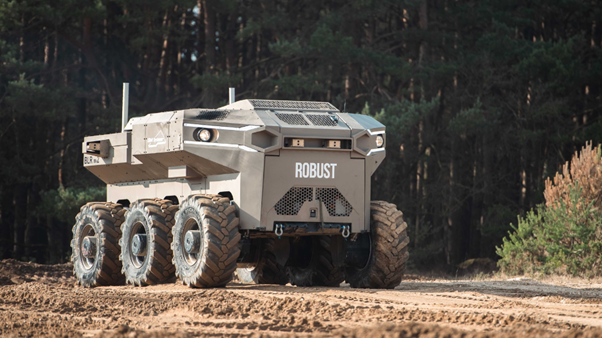
Elbit Systems ROBUST uncrewed ground vehicle was one of three platforms selected for testing by the British Army (UK MoD)
BELFAST — In a first, the United Kingdom recently tested three different heavy uncrewed ground vehicles (H-UGV) weighing over five tonnes (5.5 US tons) to evaluate speed, terrain and communication system capabilities.
Led by the Future Capability Group (FCG) from within Britain’s procurement arm Defence Equipment and Support (DE&S), Elbit’s ROBUST (ROBotic aUtonomous Sense and strike), Milrem’s Type X and Rheinmetall’s Wiesel vehicles all “underwent stringent trials” over two weeks, at the British Army’s Armoured Trials and Development Unit (ATDU) in Dorset, England, according to DE&S.
The tests are a step toward “what could potentially be achieved on the battlefield with crewless vehicles in the next 10, 20 or 30 years,” said Lt. Col. James de St John-Pryce, commanding officer of ATDU.
RELATED: In first, US Army soldiers fight with, and against, robotic vehicles in training
Elbit originally unveiled ROBUST at the Eurosatory Defense and Security Exhibition in June 2022. Developed in partnership with the Israel Ministry of Defense Directorate of Defense Research and Development (DDR&D), the vehicle hosts a 30mm autonomous turret and features Elbit’s Iron Fist Active Protection System, alongside fire control and mission management systems, according to the Israel MoD. The vehicle can also carry a capsuled drone for reconnaissance missions.
Elbit already supplies the British Army with a fleet of Watchkeeper tactical drones, used for intelligence, surveillance, target, acquisition and reconnaissance (ISTAR) missions.
Milrem describes Type X as a “wingman” for main battle tanks, designed to support mechanized units. Firepower options include 25mm to 50mm autocannons. Due to integration with a multi-canister launcher, the uncrewed vehicle and also be equipped with UVision Hero 120 and Hero-400EC loitering munitions.
RELATED: GDLS showcases short-range air defense payload on Tracked Robot 10-Ton
A joint collaboration between Milrem and Kongsberg Defence saw Type X involved in live firing trials using the Norwegian manufacturer’s PROTECTOR remote turret in June 2022. Milrem has previously participated in British Army uncrewed ground vehicle trails, including the 2018 edition of the Army Warfighting Experiment, where it put forward four TITAN modular systems for assessment.
Rheinmetall first showcased a Wiesel wingman autonomous ground vehicle concept at AUSA in 2019. The vehicle is designed as a fully digitized version of the Wiesel armored fighting vehicle, integrated with autonomous capabilities of the company’s Mission Master UGV and can be equipped with a Common Remotely Operated Weapon Station to launch Javelin missiles. It was also put forward for the US Army’s Robotic Combat Vehicle – Light (RCV-L) program.
Rheinmetall BAE Systems Land (RBSL) was contracted by the UK MoD to upgrade 148 Challenger 2 main battle tanks to a new Challenger 3 standard under a £800 million ($968 million) deal in May 2021.
Meanwhile, over in the US, the Army is also experimenting with ground robots and moving out with a new RCV rapid prototyping competition (possibly for a light class robot) with plans to spend $142 million in fiscal 2024 on that competition. Although the service released guidance to industry this week about what it is looking for, those documents outlining RCV requirements are not publicly available. However, it is possible that some of these UK-aligned RCVs could be candidates too.
Breaking Defense’s Ashley Roque contributed to this report.








